15 Worst Soda Brands to Stay Away From Right Now
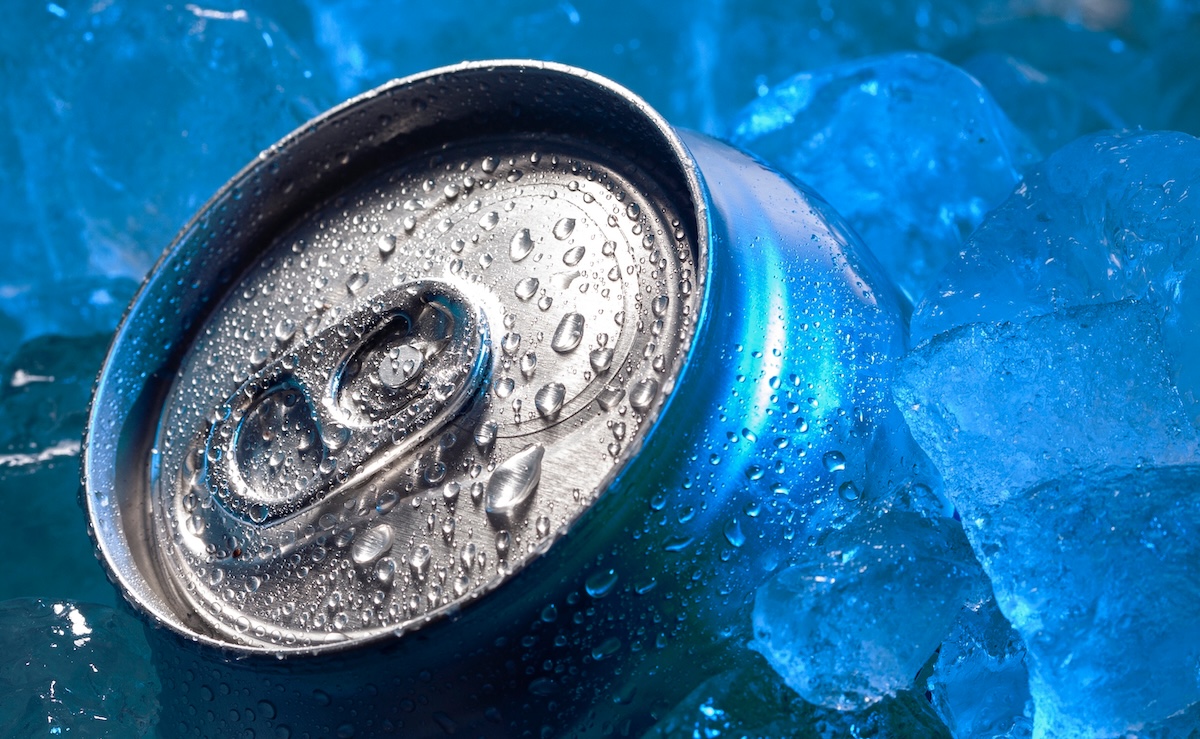
For years now, new soda brands have been popping up incessantly. It seems that every grocery store trip yields a fresh, never-before-seen pastel can. They promise "better-for-you" makeups, healthier ingredients, and a completely new way to soda.
It all begs the question, "What is so wrong with the old ones?"
Well, the answer is a lot of things. "Despite being so readily available, soda is far from healthy," shares Eddie Rodriguez-Lopez, MD, a primary care physician at Geisinger Medical Clinic Lock Haven. "In fact, drinking soda and other sugary soft drinks may be one of the leading causes of obesity. While having an occasional soda isn't going to have lasting long-term effects, having 1 or more sugary drinks every day will."
Typically present in the form of high fructose corn syrup, the glut of sugar is certainly one of the most concerning aspects of soft drinks. The American Heart Association states that, on average, women should consume no more than 25 grams of added sugar and men no more than 36 grams of added sugar per day. Meanwhile, most sodas on the market carry twice or even three times that amount in one bottle. This kind of excess consumption has been linked not just to weight gain but also to type 2 diabetes, heart disease, kidney diseases, non-alcoholic liver disease, and tooth decay, according to the CDC.
If you thought diet sodas were safe with their zero-calorie, zero-sugar recipes, think again. These beverages alternatively get their flavor from artificial sweeteners like aspartame and sucralose which come with their own wealth of concerns. Plus, many diet and regular sodas alike include other unwanted additives such as possibly carcinogenic artificial dyes and even things like brominated vegetable oil (BVO), which is still lingering in some brands despite the FDA's recent ban.
It's a bit worrying, to say the least. So, to help give you a better understanding of what's in your cup and, more importantly, what brands you may want to avoid, we've rounded up 15 of the least nutritionally-friendly sodas on the market. You might want to think twice before popping the top on these unsettling soft drinks.
Mountain Dew
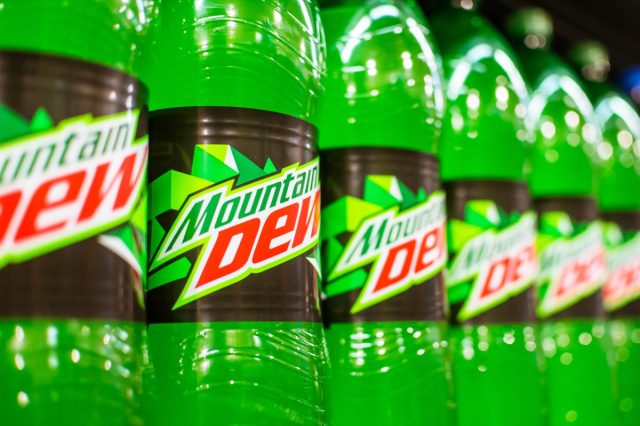
Calories: 290
Sodium: 105mg
Carbs: 77g
Sugar: 77g (77 g added sugar)
The toxic slime coloring of Mountain Dew alone makes it look like a substance that should only be handled by someone in a hazmat suit—and in reality, that might not be such a terrible idea.
The classic soda's artificial hue is actually derived from something called Yellow 5 (or tartrazine) which is a synthetic food dye commonly found in processed foods in the U.S. Other countries have limited or even banned its use. Several studies have found that prolonged ingestion of the dye could trigger carcinogenesis—the formation of cancer. Plus, artificial colorings including Yellow 5 have been linked to hyperactivity and other behavioral changes in children.
What's worse is that other Mountain Dew variations add even more questionable dyes into the mix. Take Code Red Mountain Dew for example. The jolting spinoff combines Red 40 and Blue 1 on top of Yellow 5.
Up until a few years ago, brominated vegetable oil (BVO) was also a main ingredient in the soft drink. BVO is another harmful additive that has been linked to various health concerns such as neurological issues due to the bromine it contains. The substance was also officially banned by the FDA in 2024. While BVO has since popped off the Mountain Dew ingredients list, the drink is still chock full of plenty of other less-than-ideal ingredients that are sure to do more than just "tickle your innards" (per Mountain Dew's slogan from the '60s). Each 20-ounce bottle of the fizzy drink contains 290 calories, 77 grams of sugar, and 105 mg of sodium.
Last, but not least, have you heard of something called Mountain Dew Mouth? That's the name dentists have given to the tooth decay, cavities, and other dental problems that can arise from drinking too much pop such as–you guessed it–Mountain Dew.
With all this in mind, it sounds like it's best to avoid the entire Mountain Dew family altogether—trust us, Just Dew It.
Mello Yello
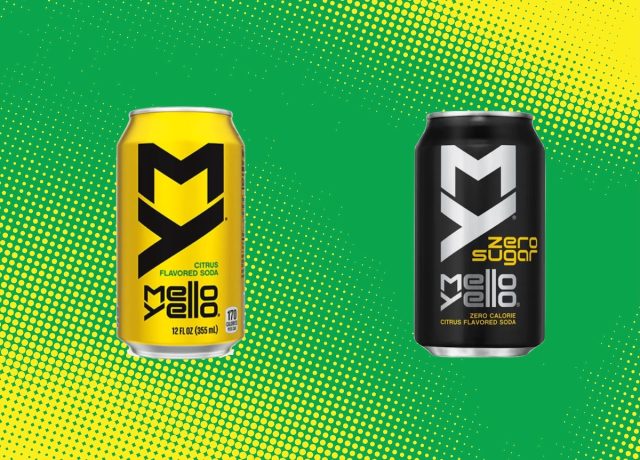
Calories: 290
Sodium: 80mg
Carbs: 78g
Sugar: 77g (77 g added sugar)
Despite its obvious health defects, Pepsi's Mountain Dew captured Americans' hearts from the beginning and quickly became one of the top-selling soda brands in the country. This success is what spurred Coca-Cola to invent its own recreation of the drink, which it dubbed Mello Yello.
Not surprisingly, Coke's neon yellow soda shares many of the same attributes as Mountain Dew, and is just as hazardous. Mello Yello also gets its coloring from Yellow 5 and packs 290 calories in a 20-ounce bottle. It further contains 78 grams of added sugar—that's over 150% of your daily intake recommendation. Mello Yello additionally has a high level of caffeine, at about 85 milligrams per 20-ounce bottle, which will have you feeling anything but mellow.
To achieve its Zero Sugar variation, the brand uses artificial sweeteners including aspartame. This is one of the more popular sugar swaps in various foods and beverages and is actually 200 times sweeter than sucrose. But, a 2022 NutriNet-Santé cohort study found that people who consumed higher levels of the substitute were more likely to develop cancer overall and particularly breast and obesity-related cancers.
For different reasons, both Mello Yello and its Zero Sugar companion have been harder to find as of late–which, for our health's sake, may just be for the best.
Sun Drop
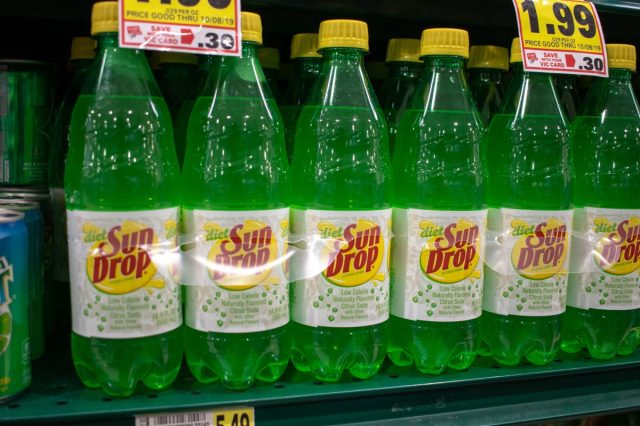
Calories: 290
Sodium: 90mg
Carbs: 76g
Sugar: 75g (75 g added sugar)
Of course, Keurig Dr. Pepper also holds a seat at the citrus-flavored soda table with its own rendition called Sun Drop. In fact, it's actually older than both Mello Yello and Mountain Dew, with roots dating back to the late 1920s, according to Southern Living.
Sun Drop matches both Mountain Dew and Mello Yello in terms of total calories and has just a little less sugar. The soda also contains additives like high fructose corn syrup and Yellow 5, and actually blows the other two brands out of the water when it comes to caffeine content, with 106 milligrams in every 20-ounce bottle.
But, what's most concerning, is that while both Coke and Pepsi have backed off from using BVO in their soft drinks, Sun Drop still contains the additive. It's mixed into the beverage because it helps to keep citrus flavors from separating out. But, it's been found that bromine–a main ingredient in BVO–can irritate your skin and other mucous membranes, and extended use can even lead to symptoms like headaches, impaired balance, or memory loss, according to Middlesex Health.
On top of that, drops of sodium benzoate and something called ester gum—an oil-soluble food additive that comes from refined wood rosin and food-grade glycerol–can also be found in Sun Drop.
Pepsi
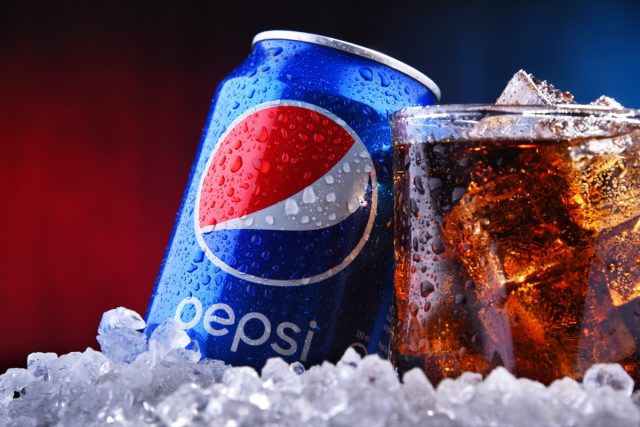
Calories: 250
Sodium: 55mg
Carbs: 69g
Sugar: 69g (69 g added sugar)
Pepsi and its arch nemesis Coca-Cola have always gone head-to-head, or can-to-can, constantly duking it out. But, there are a couple of nutritional categories where Coke currently has Pepsi edged out by just a hair. Each 20-ounce Pepsi bottle contains a smidge more sugar—69 grams compared to Coke's 65. It has a few more calories, too: 250 calories compared to 240 for Coke. Pepsi also contains more caffeine overall—that's great for those looking for a little extra oomph, but not so great for your body in the long run.
The rivals also share a nearly identical ingredient list, with one important exception: Pepsi contains citric acid while Coke does not. Citric acid naturally occurs in citrus fruits like lemons. However, the kind that is typically found in packaged foods for preservative purposes is known as manufactured citric acid and comes from an unsavory source: black mold. The FDA has classified this additive as "generally recognized as safe" for consumption—but still something to think about next time you pop the tab on that Pepsi can.
High fructose corn syrup and caramel coloring are also key players on Pepsi's ingredient list. In high doses, caramel coloring has been found to be carcinogenic. And, as for high fructose corn syrup, there are a myriad of possible negative side effects. The artificial sugar has been linked to diabetes and heart disease. It also increases your risk for weight gain, and experts widely believe that high fructose corn syrup is a major contributor to the obesity epidemic.
Dr Pepper
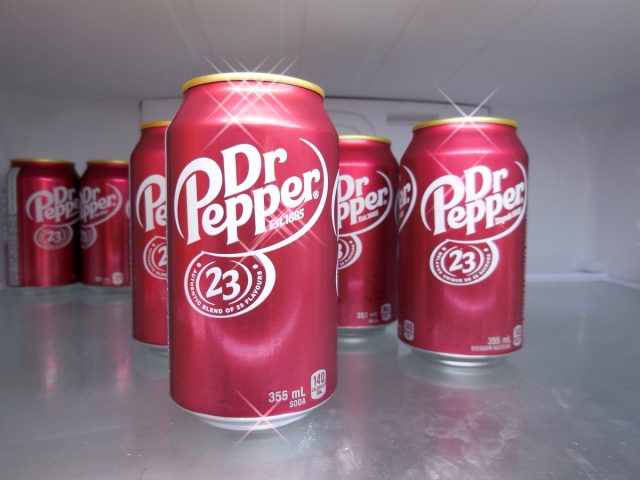
Calories: 240
Sodium: 95mg
Carbs: 66g
Sugar: 65g (65 g added sugar)
This is certainly not what the doctor ordered. Dr. Pepper commonly boasts its 23 special flavors including almond, caramel, blackberry, vanilla, nutmeg, and even things like carrot and tomato, making the drink sound like a rejuvenating medley of fresh ingredients. But, the reality is, that most of these tastes are not authentic and are instead cooked up in a lab.
Similar to other top soda brands Coke and Pepsi, Dr. Pepper's actual ingredient list consists of high fructose corn syrup and caramel coloring. This coloring agent is, again, used for nothing other than aesthetics. But, it has been linked to hypertension, liver damage, and reduced white blood cell counts.
The doctor doses out another secret ingredient as well: phosphoric acid. This compound gives Dr. Pepper its tartness. But, it's important to note that this ingredient is also commonly used in fertilizers, detergents, and other cleaning supplies.
Besides just sounding unappetizing, phosphoric acid has also been shown to have a negative effect on your kidneys and puts you at higher risk for heart disease, decreased bone density, and even osteoporosis. This is particularly a concern for women—a group that may already have mixed feelings toward the Dr. Pepper brand after the company's "It's not for women" campaign back in 2011. The campaign was meant to loop more men into the diet soda market, with a new 10-calorie Dr. Pepper. But, you can likely see why it wasn't well received.
Mug Cream Soda
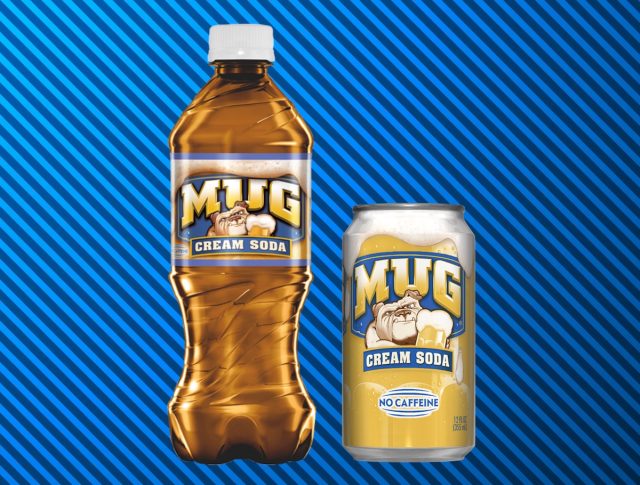
Calories: 290
Sodium: 105mg
Carbs: 79g
Sugar: 79g (79 g added sugar)
Cream soda is like the dessert of all soft drinks. And fittingly, it contains just as many, if not more, calories and sugar than many of the sweets you'd find on the market.
Mug's own velvety version specifically contains 290 calories, 105 mg of sodium (the same as Mountain Dew), and 79 grams of sugar per 20-ounce bottle. That level of sugar is equivalent to eating almost three whole Snickers bars or an entire large hot fudge sundae from Dairy Queen.
A dangerous trifecta of sodium benzoate, high fructose corn syrup, and caramel coloring is also included in Mug Cream Soda's chemical makeup. Not to mention something called yucca mohave extract makes the list. This is a plant extract that is commonly used in cosmetics and as an animal feed additive. Yucca has been given the thumbs up by the FDA, suggesting it's safe for consumption. But it certainly sounds "yuccy," doesn't it?
And, Mug Root Beer–the brand's other popular product line–isn't in the clear either. The root beer contains many of these same ingredients as its cream soda cousin but does have a slightly lower calorie and sugar count.
A&W Cream Soda
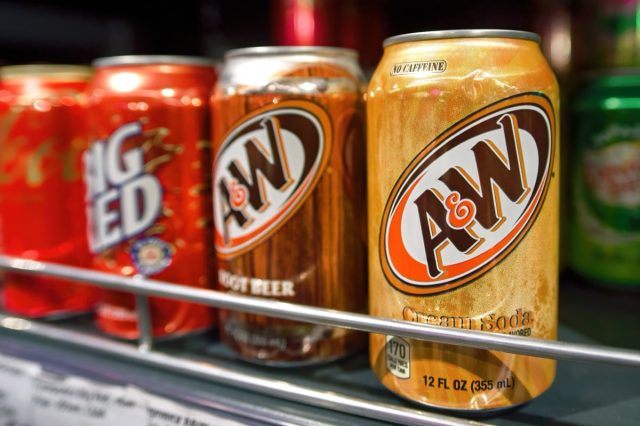
Calories: 290
Sodium: 115mg
Carbs: 77g
Sugar: 76g(76 g added sugar)
Still on the topic of cream soda, A&W doesn't do much better. Trista Best, MPH, RD, LD at Balance One Supplements shares that "a serving of this cream soda contains a substantial amount of added sugar per serving, which can contribute to excessive calorie intake and potential weight gain." She additionally adds, "Cream sodas often lack any nutritional value, providing empty calories without essential nutrients."
A&W's cream soda matches Mug's in terms of total calories per bottle at 290. Its sugar count is just a hair lower at a total of 76 added grams, and its sodium count is actually higher, weighing in at 115 milligrams–the highest amount of any soda on our list. That is, until we take a look at A&W root beer which boasts 135 milligrams along with its own 270 calories and 72 grams of sugar.
Not surprisingly, ingredients like high fructose corn syrup and artificial flavors are involved in both beverages. Plus, caramel coloring gives them their golden and dark amber hues.
Sunkist
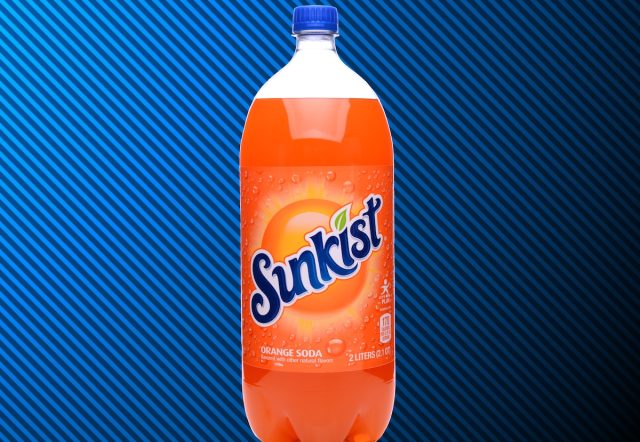
Calories: 270
Sodium: 110mg
Carbs: 74g
Sugar: 73g (73 g added sugar)
Sunkist's bright packaging with dew droplets and pictures of juicy oranges may trick you into believing the drink is made from fresh fruit and therefore can't be that bad. But, that couldn't be further from the truth. Orange sodas like Sunkist are actually one of the worst soft drink flavors you can pick for the reasons we're about to disclose.
A quick peek at the Sunkist label reveals that the word "orange" is nowhere to be found. And, with no real oranges to give it that neon orange coloring something else must be at play. Well, that would be a combination of Yellow 6 and Red 40–both chemical dyes which are highly controversial.
And, in Sunkist's other fruity flavors, there's more of the same. To achieve the purple coloring of the brand's grapeless Grape flavor, Red 40 and Blue 1 are thrown together. Red 40 and Yellow 5 work together to create Peach, and Cherry Limeade is made from Red 40 and Yellow 5. You get the idea.
In all variations, you will also find high fructose corn syrup, citric acid, and sodium benzoate as well. And while all flavors are, without a doubt, unhealthy, the top two worst flavors the brand offers are Fruit Punch and Pineapple due to their ridiculously inflated sugar content. Sunkist Pineapple holds 84 grams of sugar and Sunkist Fruit Punch stands at 80 grams–putting the drinks 320 and 300 calories per 20-ounce bottle, respectively.
Fanta
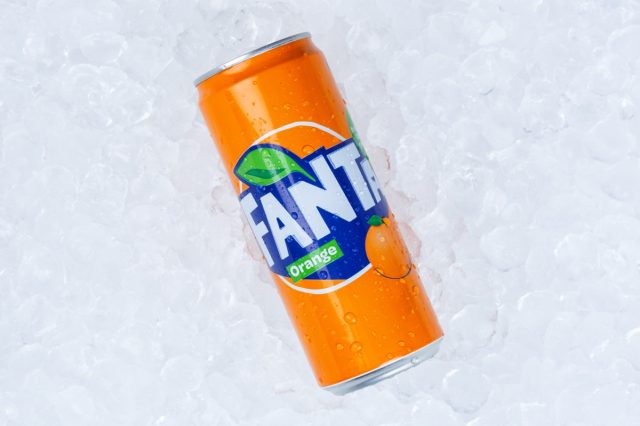
Calories: 270
Sodium: 90mg
Carbs: 73g
Sugar: 72g (72g added sugar)
Fanta's original recipe included ingredients like whey, apple pulp, beet sugar, and fruit shavings. Now, the included list of substances is much less natural and recognizable. And, in terms of nutrition info, the brand's lineup of effervescent flavors is very similar to Sunkist's.
Once again, no real oranges were harmed in the making of this beverage. High fructose corn syrup, however, is Fanta's main squeeze, and added sugar levels are on par with Sunkist at 72 total grams. The two competitors even use the exact same dyes to achieve that bright hue with Yellow 6 and Red 40.
The rest of Fanta's flavors are just another forbidden rainbow of synthetic colorings and citric acid. If we're including the Zero Sugar version then the buzzword aspartame is also thrown into the mix. If you're additionally curious about which specific tastes tip the scale the most in terms of sugar content, it's strawberry with 74 grams and pineapple with a whopping 80 grams. After hearing that, do you still "Wanta Fanta?"
Crush
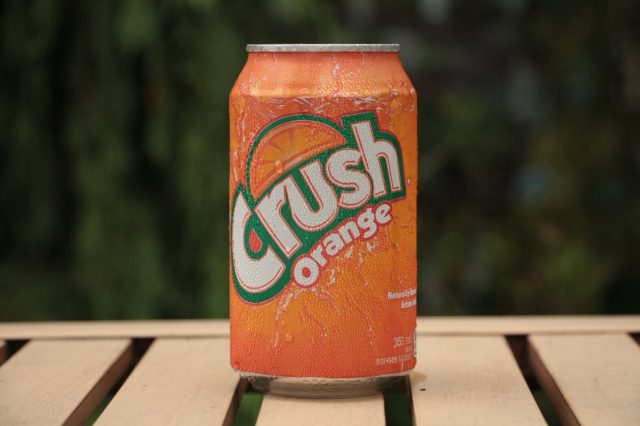
Calories: 320
Sodium: 110mg
Carbs: 86g
Sugar: 85g(85g added sugar)
Crush got its start as an orange soda—and you already know the problems associated with those including food dyes and a lack of any kind of nutritional value. But, where the brand really went off the deep end is with its pineapple flavor, which is one of the most high-calorie and sugar-filled sodas on the market.
Just like Sunkist's pineapple-flavored soda, the Crush version also has a stomach-churning 320 calories. But, it surpasses the Sunkist version with a total of 85 grams of sugar. That's 169% of your daily recommended amount.
The usual suspects appear on Crush soda's nutrition labels including high fructose corn syrup and sodium benzoate. Plus, Crush Zero Sugar Orange comes with a few extra surprises like malic acid, the preservative potassium benzoate, aspartame, sodium citrate, and acesulfame potassium. To call it a science experiment wouldn't be too far off.
Walmart Great Value Soda
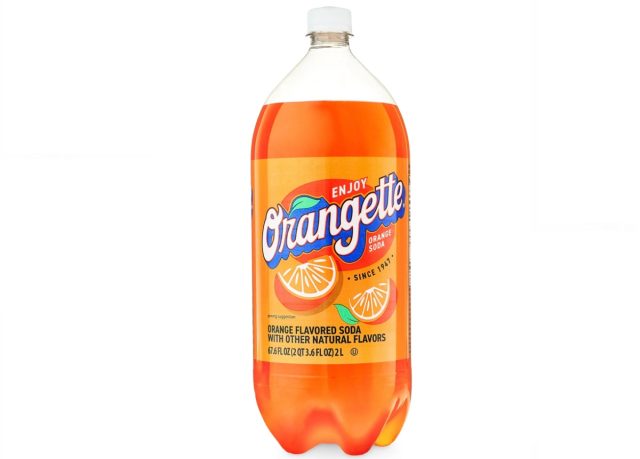
Sodium,
Calories: 300
Sodium: 58mg
Carbs: 81g
Sugar: 81g (81g added sugar)
This is one Walmart product that may help you save money but it certainly won't help you live better. The retail giant spins up its own knock-off versions of popular sodas under not-so-sneaky names like Dr. Thunder, Mountain Lightning, and Twist Up. They are sold at a bargain price, but what they offer in cost savings they lack in basic nutrition.
Even amidst growing concerns and new bans by the FDA, many of the Great Value sodas still include BVO (brominated vegetable oil) on their ingredient lists. Not to mention, their inclusion of high fructose corn syrup, aspartame in diet versions, and synthetic dyes such as caramel coloring and yellow 5 for selections like Mountain Lightning and the Pineapple Soda.
The Orangette orange soda is one of the worst offenders. Its triple threat of high fructose corn syrup, BVO, and Yellow 6 is bad enough. But then, it also squeezes in 49 grams of sugar per can (equivalent to about 81 grams per 20 ounces). If you do find yourself an incurable hankering for Great Value soft drinks, you should reach for Twist Up. The lemon-lime drink isn't the picture of health. But, it is a rare choice that doesn't include BVO, is a tad lighter on the sugar, and its clear coloring lets you know that it's free from artificial dyes.
Nehi Soda
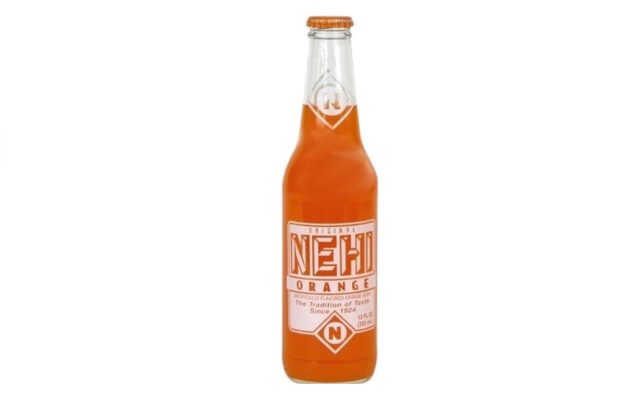
Calories: 316
Sodium: 100mg
Carbs: 86g
Sugar: 85g (85g added sugar)
Nehi is more of a nostalgic soda. A forgotten name for some people. But, it is, in fact, still on the market in original flavors of grape, orange, and peach. All three are caffeine-free. However, they are far from sugar-free. They actually boast some of the highest sugar counts in the game. The grape variety clocks in at 80 grams per 20-ounce bottle, peach comes in at 83, and orange is served up with 85 grams–tied with Crush's record-setting amount.
It should also come as no surprise that those dazzling hues are as phony as they come. There aren't many naturally occurring substances that would give the grape flavor that shade of tongue-staining deep purple. That means none other than Red 40 and Blue 1 are at work, in addition to Yellow 6 and Yellow 5 in the orange bottles.
High fructose corn syrup and additional non-disclosed artificial flavors also make this old-timey soda's ingredient label. Tack on a high sodium count and an even higher calorie count, and there's no question why it's on our watch list.
Diet Coke
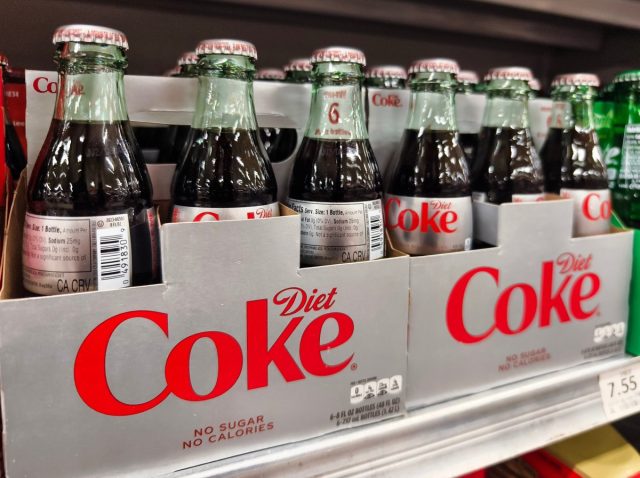
Calories: 0
Sodium: 70mg
Carbs: 0g
Sugar: 0g (0g added sugar)
When it comes to carbonated beverages, don't let the word "Diet" confuse you. Just because these picks lack sugar (and sometimes calories) doesn't mean they're good for you. You may notice diet sodas still offer a sweet sensation. Well, that's because that sugar is replaced with artificial sweeteners, which, in Diet Coke's case, comes in the form of aspartame.
Aspartame is listed as a possible carcinogenic. But, it's also been linked to neurological issues like headaches, dizziness, and cognitive impairment. These are on top of possible metabolic issues like weight gain and an increased risk for type 2 diabetes. If you've ever wondered why Diet Coke is just so dang addictive it's thanks to a combination of artificial sweeteners and caffeine.
As the cherry on top (don't get us started on Cherry Coke), the pairing of citric acid and phosphoric acid in a can of Diet Coke also makes the bubbly beverage bad for your teeth. These acids erode your tooth enamel, making you more susceptible to cavities. Just one more point to prove the "diet" soda is not only detrimental to your diet but also to your overall well-being.
Welch's Soda
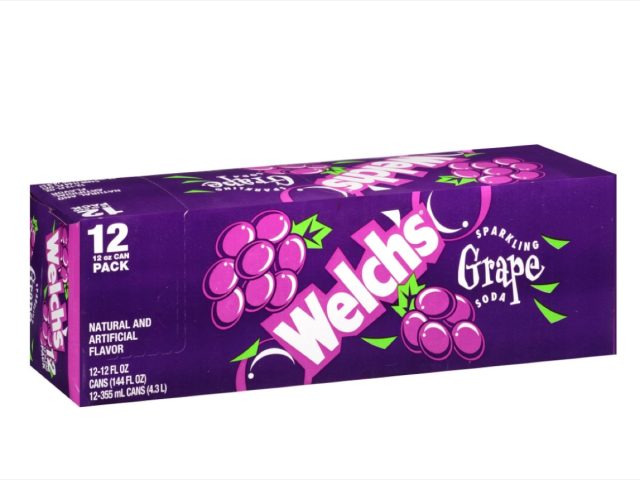
Calories: 300
Sodium: 70mg
Carbs: 80g
Sugar: 79g (79g added sugar)
Welch's Soda is a tricky one to find–available primarily at Dollar General stores of all places–and that may be for the best. Just like the brand's line of fruit juices, the sparkling sodas are also laden with sugar. But, the difference is that the sugar within the sodas is not naturally occurring. This means it doesn't come saddled with fiber and the components that help slow down the digestion process and prevent sugar spikes.
The grape variety, Welch's most prominent flavor, contains 79 grams of total added sugars. The berry soda has 66, orange holds 73, strawberry has 78, fruit punch has 80, and pineapple carries an astounding 82 grams of sugar. The tropical yellow fruit always seems to be the biggest culprit.
In addition to the processed sugar overload, none of the sparkling sodas (with the exception of grape) offer real fruit juice in their recipes. Natural and artificial fruit flavors are used instead in addition to high fructose corn syrup (no surprise there) and questionable dyes. Red 40, Blue 1, Yellow 6…the list goes on and on.
Stewart's
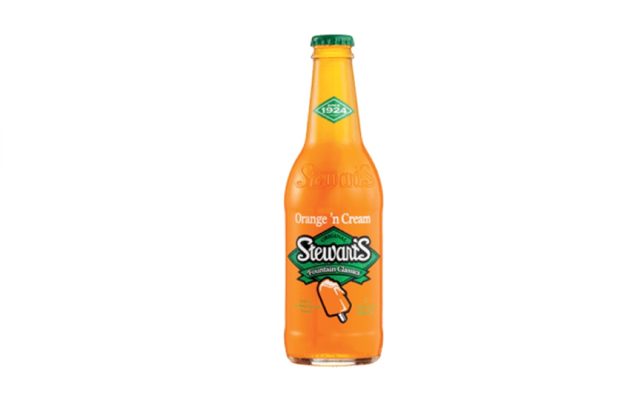
Calories: 300
Sodium: 133mg
Carbs: 75g
Sugar: 75g (75 g added sugar)
Stewart's is known for its Fountain Classics sodas still served in glass bottles in addition to its old-fashioned essence. Perhaps this is why it was so behind the times in terms of updating its ingredient list. The brand was one of the most recent to finally remove BVO from some of its recipes. Information from the Environmental Working Group (EWG) reveals that the Oranges 'n Cream variety specifically still included the substance in 2022. And, some bottles of the Key Lime flavor still contain brominated soybean oil.
Aside from this, Stewart's pops are also dripping in calories and sugar (mostly cane sugar). The Oranges 'n Cream comes on strong with 75 grams of added sugar and 300 calories per 20 ounces (calculated based on 12-ounce bottles). The Grape soda matches these numbers, the Cherries 'n Cream exceeds them, and others like Root Beer and Cream Soda aren't too far behind. As an unpalatable bonus, you also won't find any flavors without artificial colorings or dyes at play.









